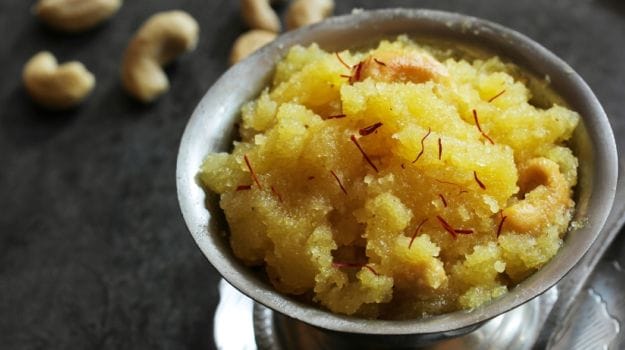One of the much cherished desserts in South India, particularly Karnataka, Rava Kesari or Kesari Bath is prepared using semolina, popularly known as rava or sooji in India. The North prepares Sooji Halwa too, which is enjoyed with fluffy hot pooris, as one rolls the sweetmeat with it. But in the South, it acquires a vibrant orange colour due to the sprinkling of kesar or saffron during the cooking process. Probably this is what sets it apart from the others, and it wouldn’t be wrong to say that Rava Kesari holds the same stature in the South as Gajar Halwa does in the North.If you happen to walk into one of those darshinis or ‘sagar’ eateries to get a taste of the local cuisine, you will often come across combinations where on one side of the plate there is a serving of a savoury dish such as Khara Bath, and next to it there is a serving of Kesari Bath. This food pairing is interestingly named as Chow Chow Bath and is a popular breakfast choice among the locals. Kesari Bath is also served with other preparations such as Vangi Bath and Bisi Bele Bath to name a few, although it could differ among restaurants.Rava Kesari – the Indian Cake
It is commendable how semolina is used in so many different ways across India. While Upma, the spices and vegetables mixed breakfast treat, seems to steal the limelight, the sweet versions too have their own set of patrons. I first tasted Rava Kesari while dining at one of the local eateries in Bangalore. Craving for some desserts post a fitting meal of dosas, vadas, lemon rice and sambhar,and determined to try something other than payasam, I chanced upon this sweetmeat and it was a pleasant surprise.It almost felt like digging into a piece of cake as the texture was similar – crumbly and delicately soft. While ghee and sugar had worked their magic in combining all the ingredients and lending it a smooth texture, cardamom had contributed to intensify the flavour and the chunks of pineapple had given it an enjoyable fruity finish. Yes, variations to the recipes also call in for fruits like pineapples, making it as relishing as Western fruit puddings. And of course, it is incomplete without the mention of saffron. The prized spice is the final ingredient which completes the dish, giving it that beautiful orange tinge. Some tend to substitute it with orange food colouring, but there’s nothing like being natural and pure. How to Make Rava KesariFollowing the same process of making halwas, Rava Kesari is easy to prepare at home as it takes only about a few minutes of your time. Remember, it is a decadent treat and if you try to cut down on ghee or sugar, you will not achieve the same flavour or texture that it is famous for. So, the trick is to make it in small portions and enjoy it in all its brilliance. For some added crunch, tip in some roasted nuts and serve it slightly warm.Here’s an easy recipe –Serves: 4
Preparation time: 20 minutes1 cup rava or semolina
3/4 cup sugar
1/2 cup ghee
3-4 strands saffron
2 Tbsp milk
1/2 cup cashews, halved
3-4 cardamomsMethod:1. Heat 1 tsp of ghee in a round bottomed pan and roast the cashews until golden. Remove from the pan and let it cool.2. In the same pan, roast the semolina on medium heat for 3-4 minutes until slightly golden. Remove from the flame and keep aside.3. Warm the milk and soak the saffron strands in it. Keep aside.4. Add 1 and ½ cups of water in a saucepan and the saffron milk, and bring it to a boil.5. Add the rava or semolina and stir well to ensure that no lumps are formed. Semolina tends to soak in water quickly, so make sure that you keep stirring the mixture to prevent it from sticking to the sides of the pan.6. While it is cooking, add the ghee, sugar and cardamom, and continue stirring. The mixture may splutter, but cover with a lid for a few minutes and continue stirring frequently.7. As the water evaporates and the mixtures leaves the side of the pan, remove from the flame and transfer it to a serving dish. Mix in the roasted nuts.8. As it cools, it will thicken to acquire a cake-like texture. Serve warm.
It is commendable how semolina is used in so many different ways across India. While Upma, the spices and vegetables mixed breakfast treat, seems to steal the limelight, the sweet versions too have their own set of patrons. I first tasted Rava Kesari while dining at one of the local eateries in Bangalore. Craving for some desserts post a fitting meal of dosas, vadas, lemon rice and sambhar,and determined to try something other than payasam, I chanced upon this sweetmeat and it was a pleasant surprise.It almost felt like digging into a piece of cake as the texture was similar – crumbly and delicately soft. While ghee and sugar had worked their magic in combining all the ingredients and lending it a smooth texture, cardamom had contributed to intensify the flavour and the chunks of pineapple had given it an enjoyable fruity finish. Yes, variations to the recipes also call in for fruits like pineapples, making it as relishing as Western fruit puddings. And of course, it is incomplete without the mention of saffron. The prized spice is the final ingredient which completes the dish, giving it that beautiful orange tinge. Some tend to substitute it with orange food colouring, but there’s nothing like being natural and pure. How to Make Rava KesariFollowing the same process of making halwas, Rava Kesari is easy to prepare at home as it takes only about a few minutes of your time. Remember, it is a decadent treat and if you try to cut down on ghee or sugar, you will not achieve the same flavour or texture that it is famous for. So, the trick is to make it in small portions and enjoy it in all its brilliance. For some added crunch, tip in some roasted nuts and serve it slightly warm.Here’s an easy recipe –Serves: 4
Preparation time: 20 minutes1 cup rava or semolina
3/4 cup sugar
1/2 cup ghee
3-4 strands saffron
2 Tbsp milk
1/2 cup cashews, halved
3-4 cardamomsMethod:1. Heat 1 tsp of ghee in a round bottomed pan and roast the cashews until golden. Remove from the pan and let it cool.2. In the same pan, roast the semolina on medium heat for 3-4 minutes until slightly golden. Remove from the flame and keep aside.3. Warm the milk and soak the saffron strands in it. Keep aside.4. Add 1 and ½ cups of water in a saucepan and the saffron milk, and bring it to a boil.5. Add the rava or semolina and stir well to ensure that no lumps are formed. Semolina tends to soak in water quickly, so make sure that you keep stirring the mixture to prevent it from sticking to the sides of the pan.6. While it is cooking, add the ghee, sugar and cardamom, and continue stirring. The mixture may splutter, but cover with a lid for a few minutes and continue stirring frequently.7. As the water evaporates and the mixtures leaves the side of the pan, remove from the flame and transfer it to a serving dish. Mix in the roasted nuts.8. As it cools, it will thicken to acquire a cake-like texture. Serve warm.
Advertisement











